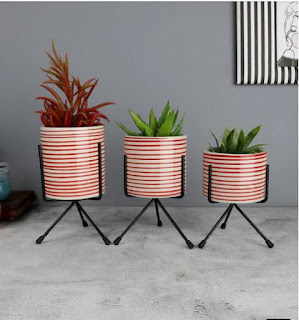What do you need to start your home garden?
Every avid gardener's dream is - a lush green balcony or even a small home garden blooming with herbs, vegetables, and flowers. Digging a home garden is rewarding and adventurous. But if you want to get your hands dirty, you need to know the gardening steps, tools, and maintenance tips.
In this article, we are going to cover some
basic know-how steps for you to start your own thriving plant paradise.
How to start your home garden?
Determine your climatic conditions
The home garden's success depends on your region's
climatic condition. For example, some plants thrive well in a temperate
climate, and others require frosty areas. Add native plants- a.k.a plants that
are indigenous to your area. Your garden will not only thrive but also will be
home to charming birds, insects & other creatures.
Think about vegetables or plants that you want to grow
After researching the native plants that can be
grown in the given climatic conditions, start deciding on what kind of
vegetables, herbs, or flowers you want to grow in your home garden. Create a
blueprint for the same in your mind. You can grow each one, or a combination
will make your garden look stunning, but the maintenance requirements may
differ. A caution- don't go overboard, especially when you don't know what you
are getting into. (Our tip- start with two to three plants utmost for the
starting few months)
Some of the best home plants to grow
● Snake plant- needs little sunshine, and water & is easy to
look after.
● Monstera- thrives in warm & humid climates, so it is ideal
to grow in India. They can grow up to large sizes but their growth can be
controlled with the help of the size of the pot.
● Baby rubber plant- this low-maintenance, humid-loving plant will
be a great addition to your house plant collection.
● Coriander/dhaniya- have a bright sunny spot in your home? Then
consider growing your own coriander. Just remember not to over-water them.
● Curry leaves- This plant also loves to have a good sunlight
bath all year round (except in summer).
Select the spot for gardening
Almost all plants need sunlight to grow. So,
pick a spot in your yard that is exposed to receive full/partial sun. Don't
worry if your yard receives little sunlight. There are many plants, like ferns,
that you can grow with little light. You can ask advice from the nursery's
staff to help you understand more. Select a flat spot for your garden to grow
crops because it is challenging and time-consuming to grow plants in a sloping
area.
Start collecting the garden essentials
Using the right garden tools will make gardening
a fun process rather instead of a chore. Collect basic gardening essentials
that are required to start your garden from scratch.
Tools that are necessary for gardening
● A hand-held trowel: It is a must-have equipment
for gardening tasks, including digging small holes, transplanting seedlings,
etc. If you are new to it, buy entry-level equipment with a solid metal blade
and wooden handle.
● Pruning shears: Whether harvesting or cutting
down those extra weeds, you require a set of pruning shears.
● Water hose pipe: A hose pipe is necessary if you
are digging the ground to put the plants. The sprayer attachment will control
water flow and pressure. If you are using pots, a watering can is the best bet
because it is feathery to carry.
● Gardening gloves: Gardening gloves prevent
blisters and scratches and keep your hands tidy.
● Garden rakes: are made from long wood handles
and are more durable than leaf rakes. It is used for grass clipping and to
create smooth ground while removing unwanted weeds.
● Pots: Potted plants bring in more versatility
than creating a soil bed. You can move the plants easily and can change the
layout. While selecting the pots, pay attention to.
○ Color- it should blend well with the natural
surroundings.
○ Quality
To achieve the best results, pick earthen pots from Vareesha
● Manure- Manure is a valuable soil that nourishes
plants with necessary nutrients like nitrogen, phosphorous, and potassium for
their growth.
Plant the crop
Some plants, like pansies and tomatoes, thrive
well in winter; others need autumn or spring to stay tall, so be sure to read
the planting time and harvesting time written on the seed packets. Follow the
instructions to improve the production.
Maintain the garden
As the garden starts to grow, you can help it
reach its full potential by maintaining it.
Water the plants regularly
While it is a common belief that watering plants
nourish them, understanding the right time is necessary to grow specific
varieties of plants. For example, most plants require 1 inch of water per week
so that the top soil stays moist and not soggy. You should water them in the
morning when the temperature is cool. Avoid mid-day watering, as it will
evaporate quickly and evening watering because it makes the soil a breeding
ground for fungi.
Remove the weeds from the plants
The weeds rob moisture and nutrients from the
plants, making them wither.
Use fertilizers & manure
The fertilizers help the plants to bloom but
apply them 6 inches above the base because when fertilizer comes in direct
touch with the plant, it can cause plant or root rotting. Immediately water it
to dilute the soil nutrients.
Sometimes the fertilizer & manure can be on
the little expensive side, so try creating your own DIY fertilizer &
manure. Click
here for detailed information
regarding the same.



Comments
Post a Comment